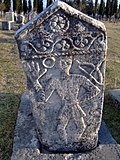| Zvečaj fortress | |
|---|---|
| Rekavice | |
 Ostaci tvrđave Zvečaj Ostaci tvrđave Zvečaj | |
 | |
| Coordinates | 44°40′18″N 17°09′37″E / 44.67163240742389°N 17.16024523561484°E / 44.67163240742389; 17.16024523561484 |
| Type | town-fortress |
| Site information | |
| Owner | The Government of Bosnia and Herzegovina |
| Condition | Ruin |
| Site history | |
| Built | Unknown-12th century |
| Built by | (unknown) |
| In use | Until 19th cen. |
| Materials | limestone in dry stone walling |
| Battles/wars | Battle of Banja Luka (1737) |
| Site is on provisional list of protected National Monument of Bosnia and Herzegovina by the Government of BiH and its KONS | |
Zvečaj fortress is ruined castle in Rekavice, Bosnia and Herzegovina. It was a strategically very important fortress in medieval Bosnia. Its ruins can still be found on the southern side of the steep slope in the Vrbas canyon. They are located about 10 km upstream from Banjaluka, or 40 km downstream from Jajce.
History and significance
Bearing in mind (for construction at that time) the unfavorable configuration of the terrain, Zvečaj was a spacious, irregularly shaped fortress, purposefully integrated into the rocky environment. Its crumbling remains are neglected and decaying.
This fortress was located in a very significant position, near the upstream entrance to the Vrbas canyon, in the Tijesno locality (behind Krupa on Vrbas). This is evidenced by the remains of three well-fortified towns: Zvečaj, Bočac and Greben. The entrance to the Vrbasa canyon, on the Banjaluka-Jajce route, is narrow and to this day the rest is really narrow, because a vertical and high rock rises right next to the bed of the Vrbasa.
Zvečaj was first mentioned on January 15, 1404, as the court of the Grand Duke of Bosnia, Hrvoje Vukčić Hrvatinić, when an alliance was signed with the people of Dubrovnik against King Stjepan Ostoja. After 15 years (March 15, 1419), Ostoj's son received the Dubrovnik envoys there and confirmed their previous privileges.
When Ključ fell in 1463, Zvečaj was occupied by the Ottomans and stationed a crew of 50 janissaries and 30 other soldiers, and appointed Konstantin of Ostrovica, writer of a well-known chronicle, as the commander. At the end of the same year, along with some other Bosnian towns, it was occupied by the king Matthias Corvinus. He also stayed in Zvečaj during his invasion of the Balkans in 1480. In the Ottoman-Hungarian treaty of 1519, Zvečaj, Banjaluka and Vrbas (Orbasz; Banya Lwka, Zweczay cum castro Verbaz) are also mentioned, which belonged to the king Louis II.
The Ottomans recaptured Zvečaj in 1528, during the governorship of Gazi Husrev-bey, when Andrija Dresneky surrendered it without resistance. That is why King Ferdinand I declared him a traitor and confiscated his possessions in Požega County, as evidenced by a document signed on 10 February 1528. There are no documents about the further fate of Zvečaj, until Battle of Banja Luka.
Zvečaj played an extremely important role in many defensive battles around Banja Luka and in Bosnia in general, including the Battle of Banja Luka in 1737.
The battle took place under Banja Luka on 4 August 1737, and the Bosnian Ottoman army won a key victory in five assaults against the Austria-Hungary. Around 1,300 dead were left behind on the side of defeated Austria-Hungarian enemy. In the battle, the Bosnian Ottoman army won the key victories, although the order arrived from Istanbul that they should not offer any resistance, and Austria-Hungary called on the Christian population not to participate in the defense of Bosnia. ↵Bosnian Vizier Hećimoglu Ali Pasha (Turkish: Hekimoğlu Ali Paşa) expected that the Austrian army would attack Bosnia. On his own initiative, he summoned all the captains and ajans to a meeting in Travnik. Since he could not get help from Istanbul, he organized the defense of Bosnia with his own forces. Relatively quickly, he gathered around 10,000 soldiers on a grassy field just outside of Banja Luka. All captains in the then Bosnian army responded to the call. The Austrian forces consisted of about 14,000 well-equipped soldiers.
Although they were attacked from several directions, from the North across the Sava and from the East across the Drina, Ali Pasha and the other leaders organized an effective defense, and in a counterattack completely beat the enemy army. For the next 150 years, Austria-Hungary will not attempt to enter Bosnia. Only in 1878, after the Congress of Berlin and approaching Ottoman Empire collapse, will Austria-Hungary enter into Bosnia again.
See also
- Vrbaški Grad
- Bočac
- Kotor Castle
- Vrbanjci
- Šiprage
References
- "Husref Redžić: Srednjovjekovni gradovi u Bosni i Hercegovini". Sarajevo publishing, Sarajevo 2009. Retrieved 9 February 2017.
- Thallozy L. (1916): Povijest Jajca. Zagreb.
- Truhelka Ć. (1904): Kraljevski grad Jajce. Glasnik Zemaljskog muzeja, Sarajevo.
- ^ Kreševljaković, H. (1953): Stari bosanski gradovi. Naše starine I.: 7-44, Sarajevo.
- ^ Pelidija E. (2002): Banjalučki boj iz 1737 - Uzroci i posljedice. El-Kalem, Sarajevo.

